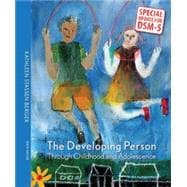DSM 5 Updates
Available for Fall 2014 classes, this update version features new content from Kathleen Berger in response to the release of the DSM-5. This new content is integrated into the text without changing pagination or the structure of the chapters. A special DSM 5 Supplement by Berger is available for Fall 2013 and Spring and Summer 2014 courses.
Available for Fall 2014 classes, this update version features new content from Kathleen Berger in response to the release of the DSM-5. This new content is integrated into the text without changing pagination or the structure of the chapters. A special DSM 5 Supplement by Berger is available for Fall 2013 and Spring and Summer 2014 courses.
View the Page-Referenced Guide to the DSM-5 updates for The Developing Person Through Childhood and Adolescence.








